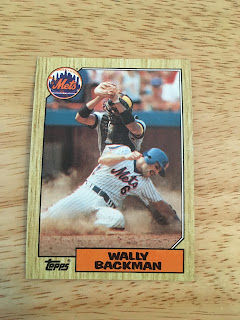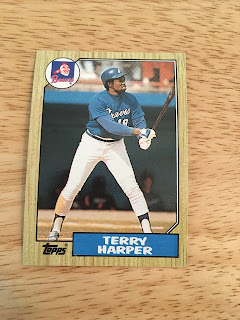Card #46: Danny Gladden
1987 stats (w/Twins): .249, 8 HRs, 38 RBIs, 25 SBs, .312 OBP, .361 SLG
Sometimes, a trade that barely registered in the small print of the transactions page is the turning point of a player’s career. Gladden didn’t necessarily become a better player after he was dealt from the Giants to the Twins (in a deal that involved four other players, only one of whom ever reached the majors). In fact, despite serving as a regular for most of his time in Minnesota, Gladden had a lower OPS+ with the Twins (90) than the Giants (106).
But Gladden became a vital part of two World Series-winning teams with the Twins. He hit a robust .314 during the 1987 postseason, which ended with the Twins outlasting the Cardinals in a seven-game World Series. Four years later, Gladden capped his Twins career in storybook fashion by racing home with the World Series-winning run in the 10th inning of one of the best games ever played, Minnesota’s 1-0 victory over the Braves.
Gladden also swiped at least 20 bases in each of his five seasons with the Twins to extend his streak of 20-steal seasons to seven. Only one player has stolen at least 20 bases in each of the last seven seasons. Name him! Most importantly, Gladden’s trade to Minnesota allowed him to fully grow out his glorious mullet, which he displayed on his 1987 Topps traded card and maintained for the duration of his stay in the Twin Cities.
Gladden ended his career by playing two more seasons with the Tigers before winning a title in Japan with the Yomiuri Giants in 1994. But his iconic status in Minnesota never wavered: He’s been a part of the Twins’ radio team since 2000.
(Trivia answer: Elvis Andrus)
Card #47: Dennis Powell
1987 stats (w/Mariners): 1-3, 3.15 ERA in 16 games (three starts), 17 Ks, 1.37 WHIP
Powell, who was dealt from the Dodgers to the Mariners in the December 1986 trade that sent Matt Young (card no. 19) to Los Angeles, didn’t get a card in the 1987 Topps traded set even though he had the best of his swingman years in his first season with the Mariners. He made 20 starts at Triple-A but produced an ERA+ of 152 in the majors, by far the best mark of his eight-year career. The highlight of his season were consecutive starts in August in which he allowed five runs over 13 innings against the Yankees and Orioles.
Powell made at least one start every season from 1985 through 1990, a stretch in which he went 7-20 with a 5.21 ERA for the Dodgers, Mariners and Brewers. Sadly, Powell dealt, on and off the field, with the unfathomable tragedies of losing three brothers and a cousin in separate car crashes in their Georgia hometown in 1989 and 1990.
He spent the 1991 season in the minors before completing his major league career with the Mariners in 1992 and 1993, though Powell pitched professionally until 1996. Powell currently represents the Dodgers at alumni events throughout California.
Card #48: Wally Backman
1987 stats: .250, 1 HR, 23 RBIs, 11 SBs, .307 OBP, .287 SLG
There are 744 cards to go, but I don’t think there’s a card in the 1987 Topps set more befitting its player than Backman’s, which pictures him grimacing as he creates a Pig Pen-esque cloud of dust by sliding under a tag at the plate. That summed up Backman, the grimiest, scrappiest, peskiest player on a 1986 World Seres-winning team filled with grinders all looking for a fight.
Backman’s career peaked in 1986, which proved to be the last season in which he collected as many as 400 plate appearances, but he remained a solid backup infielder into the early 1990s. His fieriness and ability to wring the most out of his abilities made him a natural future managerial candidate, and after five seasons as a minor league skipper, he seemed to reach the pinnacle when the Diamondbacks named him their manager following the 2004 season. But he was fired just days later after news of previous legal and financial troubles came to light (the Diamondbacks never ran a background check).
Backman went to the very bottom of the baseball ladder—independent leagues—to rebuild his managerial career and reputation and was rewarded in 2010, when the Mets hired him to manager their short-season Single-A affiliate in Brooklyn. He climbed the ladder to Triple-A Las Vegas in 2014, where he spent three successful seasons and developed a rabid cult-like following amongst a segment of fans that perpetually believed he was on the verge of replacing Terry Collins as the big league manager.
Alas, it was never happening for the fiery, profane Backman under Mets general manager Sandy Alderson, who jumpstarted the Moneyball trend of turning the manager into a yes-man whose sole job is implementing the general manager’s plan. And it’s hard to see it ever happening for Backman now that general managers are overlooking minor league managerial experience and hiring big-named ex-players just barely removed from their last big league at-bat or inning pitched. But in the fashion befitting the player pictured on a baseball card 30 years ago, Backman is headed to Mexico this season, where, despite knowing little Spanish, he’ll keep pursuing his dream by managing Monclova.
Card #49: Terry Harper
1987 stats (w/the Tigers & Pirates): .246, 4 HRs, 17 RBIs, 1 SB, .329 OBP, .385 SLG
I can’t lie: I don’t remember Terry Harper’s Topps Traded card, which pictured him as a member of a team other than the Braves for the first time. But I was impressed, here in 2017, that it showed him with the Pirates, the second of his 1987 teams, instead of the Tigers. It’s impossible to explain why this is a big deal if you weren’t 13 in 1987.
Anyway, I imagine Harper’s final big league season was a bittersweet one. He’d spent the first 13 years of his professional career with the Braves, which is no small feat in the free agency era, especially for a non-superstar. Harper was also traded to the Tigers (in exchange for pitchers Chuck Cary and Randy O’Neal) fresh off his two busiest big league seasons, a stretch in which he hit .262 with 25 homers and 102 RBIs over 244 games. That equated to an OPS+ of 99—perfectly average.
Harper collected just 130 at-bats in 1987 — his fewest since his rookie season in 1981 — and was traded from the playoff-bound Tigers to the last-place Pirates on June 26 for Shawn Holman, who made three big league appearances for the Tigers in 1989, and Pete Rice, who never reached the majors. But Harper ended his career in pretty neat fashion on Oct, 2, when he went 3-for-4 in his final game and singled in his last at-bat. That’s pretty cool. He played the 1988 season in Japan before retiring and is now a hitting coach in the Atlanta area.
Card #50: Dave Smith
1987 stats: 2-3, 1.65 ERA in 50 games, 24 saves, 73 Ks, 1.00 WHIP
Smith was one of three closers to suffer through an agonizing postseason in 1986. But while Donnie Moore and Calvin Schiraldi never recovered from their blown saves in the AL Championship Series and World Series, respectively, Smith bounced back from his rough NL Championship Series (he went 0-1 with two blown saves in the Astros’ six-game loss to the Mets) by producing his finest big league season in 1987. He produced career-best marks in ERA, WHIP, strikeouts per nine innings and strikeout-to-walk ratio. His ERA+ was 239, which is absurd for any sample size. Yet he didn’t make the All-Star Game, despite pitching in the most pitcher-unfriendly season in decades. What's up with that?
The 1987 season was the third of six straight seasons in which Smith recorded at least 30 saves while finishing with a sub-3.00 ERA. No pitcher has matched that feat the last six seasons, a stretch in which only one has recorded six 20-save seasons. Name him!
Following the 1990 season — the final season in his terrific stretch — Smith signed with the Cubs, for whom he recorded 17 saves and a 4.94 ERA in his final two big league campaigns. Smith spent two-plus seasons as a coach with the Padres before resigning to spend more time with his family in 2001, a few months after a stint in alcohol rehab. Sadly, Smith died of an apparent heart attack in December 2008 and had his ashes spread out at sea by his friend and fellow former Padres coach Tim Flannery.
(Trivia answer: Craig Kimbrel)



















